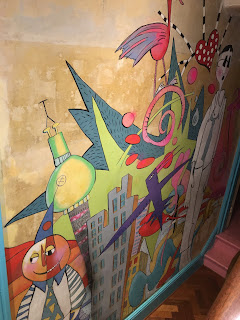Mise en scene
When filming our opening seen we wanted a large amount of focus to be put on the mise en scene, especially the props and lighting as we belived this would be the most effecive way to portray the film genre as well as hinting at where the story of the film was going to lead.Props
We had previously done a significant amont of research into religous symbolism which benefited us during the process of choosing our props to include in our sequence as it provided us with an idea of what would work. We gathered bibles and many candles as they would portray a clear religious asthetic. Within the house of the artists, we discovered several items
Within the house of the artists, we discovered several items which we belived would be perfect for our set and to help produce the eery atmosphere we were aiming to acheive. We found these old books, (shown in the picture beside), which were extremely tattered and had several symbols on them. We thougth they complemented our film genre suitably so we added them to our set. Beneath them is an old wooden box which we also found amongst the items in the house. We thought this also complemented the theme we were going for and I was please with this find.
which we belived would be perfect for our set and to help produce the eery atmosphere we were aiming to acheive. We found these old books, (shown in the picture beside), which were extremely tattered and had several symbols on them. We thougth they complemented our film genre suitably so we added them to our set. Beneath them is an old wooden box which we also found amongst the items in the house. We thought this also complemented the theme we were going for and I was please with this find.
We placed a candel next to the accumilation of books and the bible which, I belive, transformed the set into soemthing much more eerier and spookier to look at. The candle had a metal holder which had intricate detail surrounding the base giving it an ancient and more effective appearance. The candel also prodcued adequate lighting to light up the area and using this ensured that the lighing would stay consistent throughout.
In addition, we also found this chair which was clearly rather old due to the several marks and scratches it had attained. However, this gave it a more mysterious and synister look which we belived would work well for our protagonist to sit on. The rope upon it was also added to increase the effect of the mise en scene as it all worked together to produce a rather feared and mysterious appearance.


































